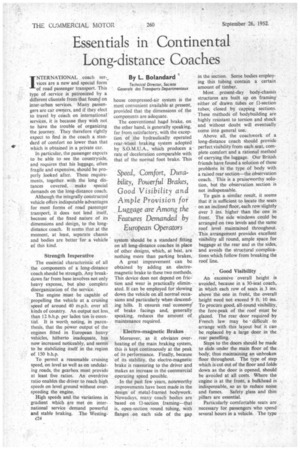Essentials in Continental Long-distance Coaches
Page 90

If you've noticed an error in this article please click here to report it so we can fix it.
By L. Bolandard
INTERNATIONAL coach services are a new and special form of road passenger transport. This type of .service is patronized by a different clientele from that found on inter-urban services. Many passengers are car owners, and if they elect to travel by coach on international services, it is because they wish not to have the trouble of organizing the journey. They therefore rightly expect to find in the coach a standard of comfort no lower than that which is obtained in a private car.
In particular, the passenger expects to he able to see the countryside, and requires that his luggage, often fragile and expensive, should be properly looked after. These requirements, together with the long distances covered, make special demands on the long-distance coach.
Although the integrally constructed vehicle offers indisputable advantages for most forms of road passenger transport, it does not lend itself, because of the fixed nature of its dimensions and design, to the longdistance coach. It seems that at the moment, at least, separate chassis and bodies are better for a vehicle of this kind.
Strength Imperative
The essential characteristic of all the components of a long-distance coach should be strength. Any breakdown far from base involves not only heavy expense, but also complete disorganization of the service.
The engine must be capable of propelling the vehicle at a cruising speed of around 40 m.p.h. over all kinds of country. An output not less_ than 12 b.h.p. per laden ton is essential. It is worth. noting, in parenthesis, that the power output of the engines fitted in European heavy vehicles, hitherto inadequate, has now increased noticeably, and seems to be stabilizing itself in the, region of 150 b.h.p.
To permit a reasonable cruising speed, on level as well as on undulating roads, the gearbox must provide at least five ratios. An overdrive ratio enables the driver to reach high speeds on level ground without overspeeding the engine.
High speeds and the variations in gradient which are met on international service demand powerful and stable braking. The Westing c24 house compressed-air system is the most convenient available at present, provided that the dimensions of the components are adequate.
The conventional hand brake, on the other hand, is generally speaking, far from satisfactory, with the exception of the hydraulically operated rear-wheel braking system adopted by S.O.M.U.A., which produces a rate of deceleration comparable with that of the normal foot brake. This system should be a standard fitting on all long-distance coaches in place of other designs, which, at best, are nothing more than parking brakes, A great improvement can be obtained by adding an electromagnetic brake to these two methods. This device does not depend on friction and wear is practically eliminated. It can be employed for slowing down the vehicle on all normal occasions and particularly when descending hills. It ensures real economy" of brake facings and, generally speaking, reduces the amount of maintenance required.
Electro-magnetic Brakes
Moreover, as it obviates overheating of the main braking system, this is kept continuously at the peak of its performance. Finally, because of its stability, the electro-magnetic brake is reassuring to the driver and makes an increase in the commercial operating speed possible.
In the past few years, noteworthy improvements have been made in the design of metal-framed bodywork. Nowadays, many coach bodies are based on 12-section framing—that is, open-section round tubing, with flanges on each side of the gap in the section. Some bodies employing this tubing contain a certain amount of timber.
Most present-day body-chassis structures are built up on framing either of drawn tubes or 11-section tubes, closed by capping sections. These methods of bodybuilding are highly resistant to torsion and shock and without doubt will eventually come into general use.
Above all, the coachwork of a long-distance coach should provide perfect visibility from each seat, complete comfort and a rational method of carrying the luggage. Our British friends have found a solution of these problems in the type of body with a raised rear section—the observation coach. This is a praiseworthy solution, but the observation section is not indispensable.
To gain a similar result, it seems that it is sufficient to locate the seats on an inclined floor, each row slightly over 3 ins, higher than the one in front. The side windows could be arranged on two levels and the same roof level maintained throughout. This arrangement provides excellent visibility all round, ample space .for baggage at the rear and in the sides, and avoids the structural complications which follow from breaking the roof line.
Good Visibility An excessive overall height is avoided, because in a 30-seat coach, in which each row of seats is 3 ins. above the one in front, the overall height need not exceed 9 ft. 10 ins. To procure good, all-round visibility, the fore-peak of the roof must be glazed. The rear door required by French law may be difficult to arrange with this layout but it can be replaced by a large door in the rear panelling.
Steps to the doors should be made to slide under the main floor of the body, thus maintaining an unbroken floor throughout. The type of step which is cut out of the floor and folds down as the door is opened, should be avoided at all costs. Where the engine is at the front, a bulkhead is indispensable, so as to reduce noise and fumes. Safety glass and thin pillars are essential.
Particularly comfortable seats are necessary for passengers who spend several hours in a vehicle. The type




































































































































































































































































































